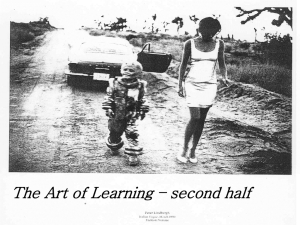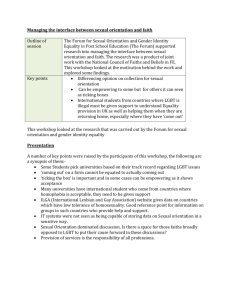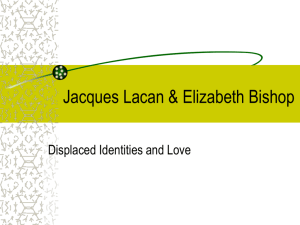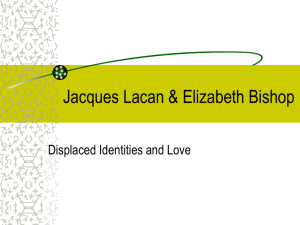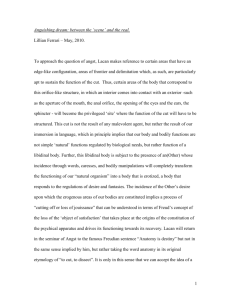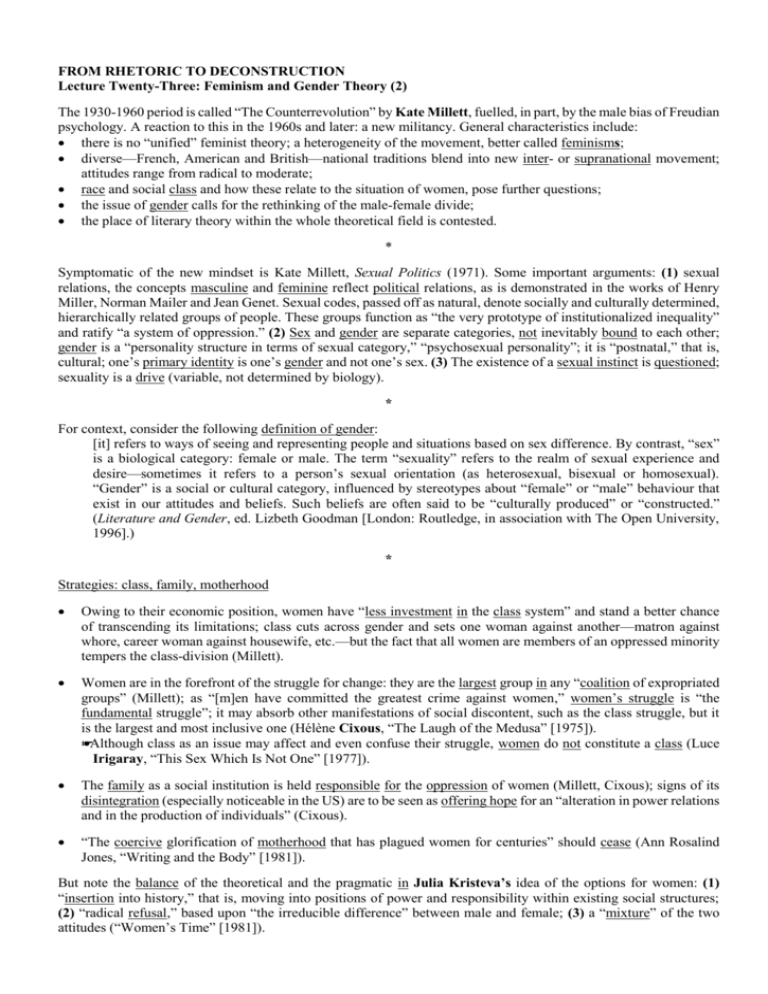
FROM RHETORIC TO DECONSTRUCTION
Lecture Twenty-Three: Feminism and Gender Theory (2)
The 1930-1960 period is called “The Counterrevolution” by Kate Millett, fuelled, in part, by the male bias of Freudian
psychology. A reaction to this in the 1960s and later: a new militancy. General characteristics include:
there is no “unified” feminist theory; a heterogeneity of the movement, better called feminisms;
diverse—French, American and British—national traditions blend into new inter- or supranational movement;
attitudes range from radical to moderate;
race and social class and how these relate to the situation of women, pose further questions;
the issue of gender calls for the rethinking of the male-female divide;
the place of literary theory within the whole theoretical field is contested.
*
Symptomatic of the new mindset is Kate Millett, Sexual Politics (1971). Some important arguments: (1) sexual
relations, the concepts masculine and feminine reflect political relations, as is demonstrated in the works of Henry
Miller, Norman Mailer and Jean Genet. Sexual codes, passed off as natural, denote socially and culturally determined,
hierarchically related groups of people. These groups function as “the very prototype of institutionalized inequality”
and ratify “a system of oppression.” (2) Sex and gender are separate categories, not inevitably bound to each other;
gender is a “personality structure in terms of sexual category,” “psychosexual personality”; it is “postnatal,” that is,
cultural; one’s primary identity is one’s gender and not one’s sex. (3) The existence of a sexual instinct is questioned;
sexuality is a drive (variable, not determined by biology).
*
For context, consider the following definition of gender:
[it] refers to ways of seeing and representing people and situations based on sex difference. By contrast, “sex”
is a biological category: female or male. The term “sexuality” refers to the realm of sexual experience and
desire—sometimes it refers to a person’s sexual orientation (as heterosexual, bisexual or homosexual).
“Gender” is a social or cultural category, influenced by stereotypes about “female” or “male” behaviour that
exist in our attitudes and beliefs. Such beliefs are often said to be “culturally produced” or “constructed.”
(Literature and Gender, ed. Lizbeth Goodman [London: Routledge, in association with The Open University,
1996].)
*
Strategies: class, family, motherhood
Owing to their economic position, women have “less investment in the class system” and stand a better chance
of transcending its limitations; class cuts across gender and sets one woman against another—matron against
whore, career woman against housewife, etc.—but the fact that all women are members of an oppressed minority
tempers the class-division (Millett).
Women are in the forefront of the struggle for change: they are the largest group in any “coalition of expropriated
groups” (Millett); as “[m]en have committed the greatest crime against women,” women’s struggle is “the
fundamental struggle”; it may absorb other manifestations of social discontent, such as the class struggle, but it
is the largest and most inclusive one (Hélène Cixous, “The Laugh of the Medusa” [1975]).
☛Although class as an issue may affect and even confuse their struggle, women do not constitute a class (Luce
Irigaray, “This Sex Which Is Not One” [1977]).
The family as a social institution is held responsible for the oppression of women (Millett, Cixous); signs of its
disintegration (especially noticeable in the US) are to be seen as offering hope for an “alteration in power relations
and in the production of individuals” (Cixous).
“The coercive glorification of motherhood that has plagued women for centuries” should cease (Ann Rosalind
Jones, “Writing and the Body” [1981]).
But note the balance of the theoretical and the pragmatic in Julia Kristeva’s idea of the options for women: (1)
“insertion into history,” that is, moving into positions of power and responsibility within existing social structures;
(2) “radical refusal,” based upon “the irreducible difference” between male and female; (3) a “mixture” of the two
attitudes (“Women’s Time” [1981]).
Lecture Twenty-Three: Feminism and Gender Theory 2
Lacan embraced and criticized
Lacan’s restatement of “Freud’s theories in the language of Saussure”: the imaginary (maternal, emotional) versus
the symbolic (paternal, rational). This dichotomy is replicated in literature: irregular syntax, incoherence in the poets
of the Decadence (Mallarmé), by means of which they undermine the authority and law inherent in language and
approximate the medium to the anarchic and the sensuous—the mother’s phase in the child’s
development→“[a]narchism is the philosophical and social position” to be adopted by the kind of feminism that wants
to destroy the “dominance of phallogocentrism” (Selden and Widdowson, A Reader’s Guide [1993]).
Desire in Lacan: language (discourse) never fully represents things, there is always a gap between what is verbalized
(signifier) and what cannot be verbalized (signified); desire is the welling-up of the unconscious in the subject ( = the
individual human being) caused by this division between what we want and what we get; desire is a longing for the
happy (imaginary, maternal) state where there was no such division. (Price Herndl [1991]); as the “subject” stands
between the two (what is wanted and what can be had), it is not a fixed but a changing entity; for Marxist feminists it
is here that the possibility of an alteration of consciousness (of the subject) may occur (Catherine Belsey,
“Constructing the Subject . . .” [1985]).
Rejection of the Lacanian thesis: the pleasure that would (but does not) ensue upon fulfilment of desire is “the
irrecoverable memory” of the happy (imaginary, maternal) state left behind when the subject moves into the symbolic,
desire is, therefore, incestuous and thus heterosexual; it originates prior to the law (the symbolic, discourse, language)
in the natural (imaginary, maternal) state. Judith Butler: Contrary to what Lacan claims, desire is the product of the
very prohibition (in the symbolic order) that forbids it. As the symbolic is structured by language, the heterosexuality
supposedly grounding the incest taboo is produced by discourse/culture and not by nature, and so is incest (Gender
Trouble [1990]).
There is no nature-determined sexual identity, which prefigures gender identity. There is no determinacy in the
(symbolic) formation of gender identity, either. The formation of gender identity is a signifying process of (1)
inscribing “identificatory” meanings on the subject, (2) generating the subject, which, however, “is not determined
by the rules through which it is generated because signification is not a founding act, but, rather a regulated process
of repetition.” The repetitiveness makes possible assertions of “alternative domains of cultural intelligibility” as it is
possible for the subject to assume identities recognizable but transcending the “convergence of discursive
injunctions,” such as “a good mother,” “a heterosexually desirable object,” “a fit worker,” etc. (Butler).
Literary theory
Studies of how literature reinforces idea of male supremacy—compare Shoshana Felman’s analysis of Balzac’s
“Adieu” (1830) in which successful male hero meets one-time mistress, now mad and destitute, and recalls her former
state when she was “ ‘the glory of her lover, the queen of the Parisian ballrooms,’ ” lamenting that “ ‘[a]las! even the
eyes of her most devoted friend could perceive nothing feminine left in that heap of linens and rags.’ ” Femininity
associated with degrading qualities (mistress, object of envy, etc.) (“Women and Madness” [1975])
Poetic language has something fundamental in common with the language of the child in the imaginary phase:
“rhythms and intonations anterior to the first phonemes, morphemes, lexemes and sentences.” Particularly
characteristic in musical and nonsense effects, irregular syntax in experimental poetry (Mallarmé, Dadaism,
Surrealism) (Kristeva, Desire in Language [1977]).
The specificity of women’s literary practice to be found, by gynocriticism, not in the reflection of the body, language,
psyche in literature, but in culture; it is the binding force of women’s culture that links women writers together over
time and space; its place within the dominant male culture: muted—the wilde zone. “Dominant” and “muted” stories
to be looked for in women’s literature, which is a “double-voiced discourse” (Elaine Showalter, “Feminist Criticism
in the Wilderness” [1981]).


